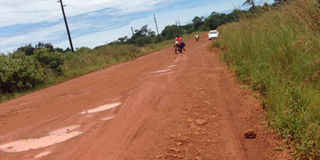Motorists angry over bad Kalangala roads

Poor state. A section of Luuku-Mulabana-Kalangala road which has developed potholes four years after being commissioned. PHOTO BY SYLEVSTER SSEMUGENYI
What you need to know:
- In 2013, government through a public-private partnership unveiled a multi-million dollar project to spur economic growth in Kalangala District.
Motorists using the Luuku–Mulabana- Kalangala road have expressed concern over the deteriorating state of the road.
They claim the road has started developing potholes, less than four years after it was constructed.
Motorists argue that the worst part of the road is the 30-kilometre stretch between Bugoma and Bweya.
Luuku–Mulabana-Kalangala main road is the face of the island district which connects to Bugala, the second biggest island on L.Victoria.
“The widening potholes have made it hard for us to operate along the road,” Mr Moses Tugumisiriza, a taxi driver, says
Mr Shaban Ssemuganga, another taxi driver, operating between Kalangala Town and Masaka, says the bad state of roads has caused mechanical breakdowns.
“The poor state of the road has forced us to use very old vehicles because you can’t use a new one for taxi business. We have also lost lives of our dear ones because the ambulance can’t drive faster to catch the ferry and connect to the mainland,” he says
“The problem has been aggravated by the current rainy season,” Mr Musa Kabito, another motorist, says.
Agreement
In 2009, government signed an agreement with Kalangala Infrastructure Services Limited (KIS) to expand and upgrade a 66-kilometre road to a Class B gravel.
A total of Shs13.5b was budgeted for the project and actual construction works started in 2015 and completed in 2016.
Mr Samuel Ssekindi, a resident of Munabana, says if no repairs are done on the road by end of November, they will be forced to plant banana suckers in the middle of the road in protest.
“December is usually a busy month for islanders, that is when we receive huge numbers of tourists, where will they pass when the road is impassable?” he asked.
Mr Navali Mukajanga, the district engineer, says the project was meant to be supervised by Uganda National Roads Authority (Unra) and KIS, and the district was only involved at negotiating for compensation of project.
“That road is part of the 10,000km taken over by Unra from local governments across the country. Personally, I would blame the contractor for not carrying out routine and periodic maintenance, there is really no value for money,” Mr Mukajanga says.
Mr Willy Lugoloobi, the district chairperson, says there is little hope for repair of the road given the fact that it was not catered for in the 2019/2020 budget.
“... The culverts were poorly installed and do not meet the standard sizes agreed upon,” Mr Lugoloobi adds
He says grass meant to be planted at Kinyenye and Bukuzindu swamps to control erosion, was not done.
However, KIS public affairs manager, Mr Joseph Mulindwa, says their contract with Unra for upgrading the road ended in 2015 when they upgraded the road to Class B gravel.
“We upgraded that road to class B gravel, the work was well done by the company and its now Unra responsible for its routine maintenance, further upgrade, and expansion” Mr Mulindwa says
Unra spokesperson Mark Ssali could not answer our repeated calls by press time.
The Works minister, Gen Edward Katumba Wamala, says his ministry was not privy to the agreement government signed with KIS.
Economic growth
In 2013, government through a public-private partnership unveiled a multi-million dollar project to spur economic growth in Kalangala District.
The Shs184 billion public-private partnership scheme which was facilitated by KIS focused on providing marine transport services, clean water access, electricity and road construction.
This saw the purchase of two ferries. The MV Pearl was the first to be procured replacing a small dilapidated ferry that used to ply the same route.
A year later, another ferry MV Ssese was also built to ease transport on the route. Electricity and clean water have also been extended to at least 70 per cent of households on Bugala Island .



